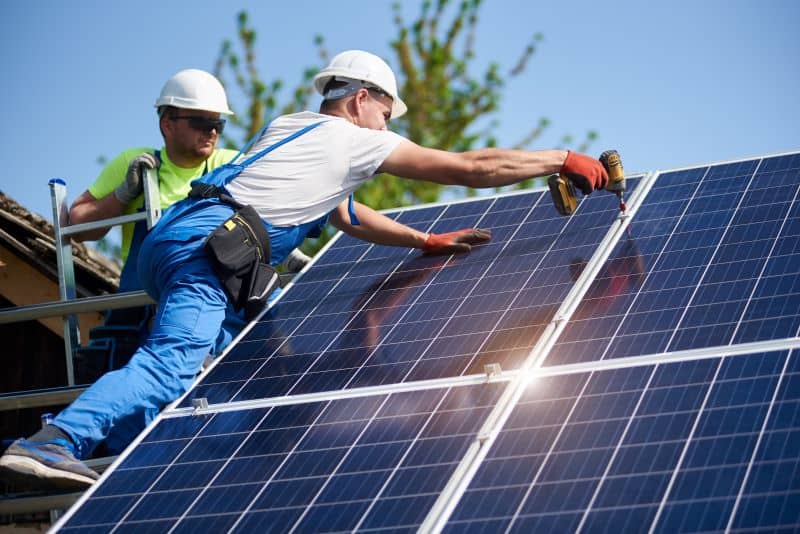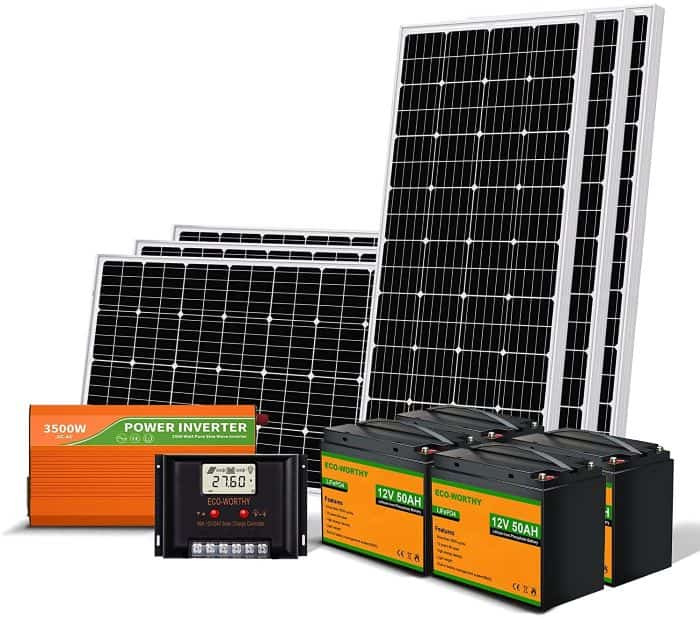
How does solar power work? In just one hour, the sun delivers more energy to our planet than the entire population uses in a year. We are just beginning to scratch the surface of solar power potential.
As solar panels pop up across the US, more and more people are wondering how they work. Will installing panels on your home save you money? Or benefit the environment? The simple answer to both questions is yes.
But let’s slow down a bit and first look at the basic process of creating solar energy.
In a Nutshell: How Does Solar Power Work
The answer to the question “How does solar power work?” begins with solar panels. Most solar panels are made of two layers of silicon. One layer has silicon plus a material that will create a negative charge, and the other layer has silicon plus a material that will create a positive charge. When the silicon layers are activated by sunlight, the opposing charges in the layers form an electric field.

The collected energy is a direct current (DC), not the type of electricity you use in your home (AC). An inverter is required to convent DC into an alternating current (AC). AC is the kind of power you traditionally get from utility companies.
Nothing else is different between solar energy and your typical electricity. You can use your converted solar power the way you usually use electricity from the power company.
Common Questions About Solar Power
Now that you know the basic process, you probably still have some questions about solar power. Here are some of the most common:
Is Solar Power a Clean Energy Source?
Yes. The most common concern of typical energy production through fossil fuels is the emission of toxic chemicals into the atmosphere. However, no greenhouse gasses are produced in the production of solar power.
Also, since solar energy comes from our sun, it’s a completely renewable resource. Unlike fossil fuels, which are a limited and rapidly depleting energy source. Solar power is one way to reduce our carbon footprint.
Will Installing Solar Panels Save Money?
Yes, but it may take some time. Solar panels and their installation can be pricey. But financing is often available. In general, your electric bill should decrease or disappear entirely. Some energy providers are even willing to buy extra energy from you if you produce more energy than you need.
Solar panels have an average lifespan of 25-30 years, so they have plenty of time to earn their keep. Payback estimates depend on your typical energy use and how much sunlight you get, but an average payback period is 6-8 years before your panels save you more money than the initial cost.
A complete solar system for a suburban home can cost many thousands of dollars. These systems should be installed by contractors who have an expertise in this field.
But there are also solar power kits that can be installed by solar contractors or experienced do-it-yourself homeowners. The Eco-Worthy 1200-Watt Solar Power Kit includes six solar panels, 4 lithium batteries, an inverter and a controller. This system generates approximately 5KW hours per day in 4 hours full sunlight. That’s enough power for an air conditioner, TV, refrigerator, and other 110-volt AC devices. This is a great option for small homes, cabins and sheds. Check Price on Amazon.
Portable Solar Power Kits
Campers and RV owners are also embracing portable solar power kits. One example is the EcoFlow Portable Solar Power Station. This kit includes a foldable solar panel and a portable power station/battery. Just plug the solar panel into the power station, and the battery hits 80% of capacity in just one hour. It’s great for camping, outdoors, hunting, RVs and emergency backup power. Check Price on Amazon.
Home Garden and Homestead receives a small commission (at no cost to you) for the Amazon links in this story.
How Does Solar Power Work at Night?
Solar panels need one main thing to work, sunlight. So, many people wonder how they will be able to produce solar power at night. When solar panels can’t absorb any new sunlight, you can rely on excess stored energy they create during the day.
You have two possibilities for storing solar electricity: solar batteries and staying attached to the power grid. Solar batteries can store the power for use whenever you need it. And connecting to the grid means that you would never end up without power if your solar runs out. Either way, your new electric meter will keep track of the energy created and consumed.
How Do Solar Panels Work in Winter?
Absolutely! Since solar panels create energy from sunlight, not heat, the cold temperatures of winter do not negatively impact their energy production. The angle of panels and the materials can help shed snow efficiently. Even though cloudy days can affect output, ground snow can help reflect and increase light absorbed by the panels.
The Future of Solar Power
Clean solar energy has an enormous potential to positively impact the environment. As such, many countries are making it a priority to invest in solar power advancements. The US has plans for 45% of the nation’s energy to come from solar power by 2050. Soon, we may even be able to create electricity from the pressure of raindrops with new hybrid panels.





Your article on how solar power works was a valuable resource for anyone seeking to understand the fundamentals of this renewable energy source. Your writing style and ability to present technical information in an accessible manner are commendable.
Thank you for sharing your expertise and contributing to the dissemination of knowledge in the field of renewable energy. I look forward to reading more of your work in the future.
Thank you for describing how a full solar energy system for a suburban home might cost several thousand dollars. Contractors with experience in this area ought to implement these systems. I’ll let my parents know about this as they want to get solar panels put in before the month is through. I’ll advise them to look for a professional installer so that the installation may be done correctly the first time.